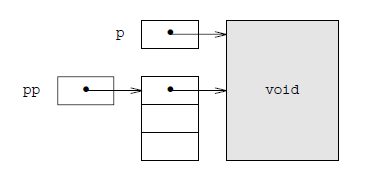《OOC》笔记(1)——C语言const、static和extern的用法
《OOC》笔记(1)——C语言const、static和extern的用法
C语言中const关键字用法不少,我只喜欢两种用法。一是用于修饰函数形参,二是用于修饰全局变量和局部变量。
用const修饰的函数形参
直接修饰
一个形如
int Minus(const int a, const int b, int testCase);
的函数,const的意义是什么呢?
答:参数a被const修饰,说明在Minus函数内,编译器不允许a被别的变量(例如x)赋值(修改)。参数b同理。
如果你写了a = x; 这样的语句,编译器会警告"warning: assignment of read-only location",即"警告:赋值到只读位置"。
1 int Minus(const int a, const int b, int testCase) 2 { 3 int x, y; 4 switch (testCase) 5 { 6 case 0: 7 a = x; //warning: assignment of read-only location 8 b = y; //warning: assignment of read-only location 9 break; 10 case 1: 11 a = (const int)x; //warning: assignment of read-only location 12 b = (const int)y; //warning: assignment of read-only location 13 break; 14 case 2: 15 x = a; //OK with compiler. 16 y = b; //OK with compiler. 17 break; 18 case 3: 19 x = (int)a; //OK with compiler. 20 y = (int)b; //OK with compiler. 21 break; 22 default: 23 break; 24 } 25 int result = a - b; 26 return result; 27 }
指针修饰
请原谅这个不靠谱的的叫法吧。总之,一个形如
int Add(const int * a, const int * b, int testCase);
的函数,const的意义是什么呢?
答:参数a是指向int的指针,a被const修饰,说明在Add函数内,a指向的内容不能被赋值(修改)。如果将a赋值给另一个int*类型的指针x,那么就可以通过x修改a指向的内容。这违反了const的作用。因此,编译器禁止将a赋值给别的变量。参数b同理。
如果你写了x = a; 这样的语句,编译器会警告"warning: assignment discards qualifiers from pointer target type",即"警告:赋值无视目标指针的修饰符"。
1 int Add(const int * a, const int * b, int testCase) 2 { 3 int * x; 4 int * y; 5 switch (testCase) 6 { 7 case 0: 8 a = x; //OK with compiler. 9 b = y; //OK with compiler. 10 break; 11 case 1: 12 a = (const int *)x; //OK with compiler. 13 b = (const int *)y; //OK with compiler. 14 break; 15 case 2: 16 x = a; //warning: assignment discards qualifiers from pointer target type 17 y = b; //warning: assignment discards qualifiers from pointer target type 18 break; 19 case 3: 20 x = (int *)a; //OK with compiler, but const fade out. 21 y = (int *)b; //OK with compiler, but const fade out. 22 break; 23 case 4: 24 *a = *x; //warning: assignment of read-only location 25 *b = *y; //warning: assignment of read-only location 26 case 5: 27 *x = *a; //OK with compiler, but const fade out. 28 *y = *b; //OK with compiler, but const fade out. 29 default: 30 break; 31 } 32 int result = *a + *b; 33 return result; 34 }
总结以上两种情况,就是"当const修饰一个普通变量时,则这个普通变量不应被修改。当const修饰一个指针变量时,这个指针指向的内容不应被修改,也不应让其它指针指向这个内容。"
用const修饰全局变量和局部变量的思想同上。
用static修饰的函数和变量
如果在头文件x.h中声明的函数和变量如下
extern static int startPoint; static int Add(int a, int b);
在源文件x.c中定义如下
1 static int startPoint = 100; 2 static int Move(int a) 3 { 4 return startPoint + a; 5 }
那么这个Move函数就只能在x.c这个源文件中使用。这相当于面向对象里的class里的私有函数了。
用static修饰的变量startPoint,也只能在x.c这个源文件中使用,这相当于面向对象里的class里的私有静态变量。
同时,这里也显示了extern用于声明全局变量的方法。首先在头文件x.h里用extern修饰该变量的声明部分,然后在源文件x.c中定义该变量。
在x.h和x.c里的示例中,我们同时用extern和static修饰了全局变量startPoint,那么这个startPoint变量就只能在源文件x.c中出现了。如果去掉static,那么startPoint就能够在所有写了"include "x.h""的源文件中使用了。

|
微信扫码,自愿捐赠。天涯同道,共谱新篇。
微信捐赠不显示捐赠者个人信息,如需要,请注明联系方式。 |

 当const修饰一个普通变量时,则这个普通变量不应被修改。当const修饰一个指针变量时,这个指针指向的内容不应被修改,也不应让其它指针指向这个内容。extern用于声明全局变量的方法:首先在头文件x.h里用extern修饰该变量的声明部分,然后在源文件x.c中定义该变量。
当const修饰一个普通变量时,则这个普通变量不应被修改。当const修饰一个指针变量时,这个指针指向的内容不应被修改,也不应让其它指针指向这个内容。extern用于声明全局变量的方法:首先在头文件x.h里用extern修饰该变量的声明部分,然后在源文件x.c中定义该变量。
